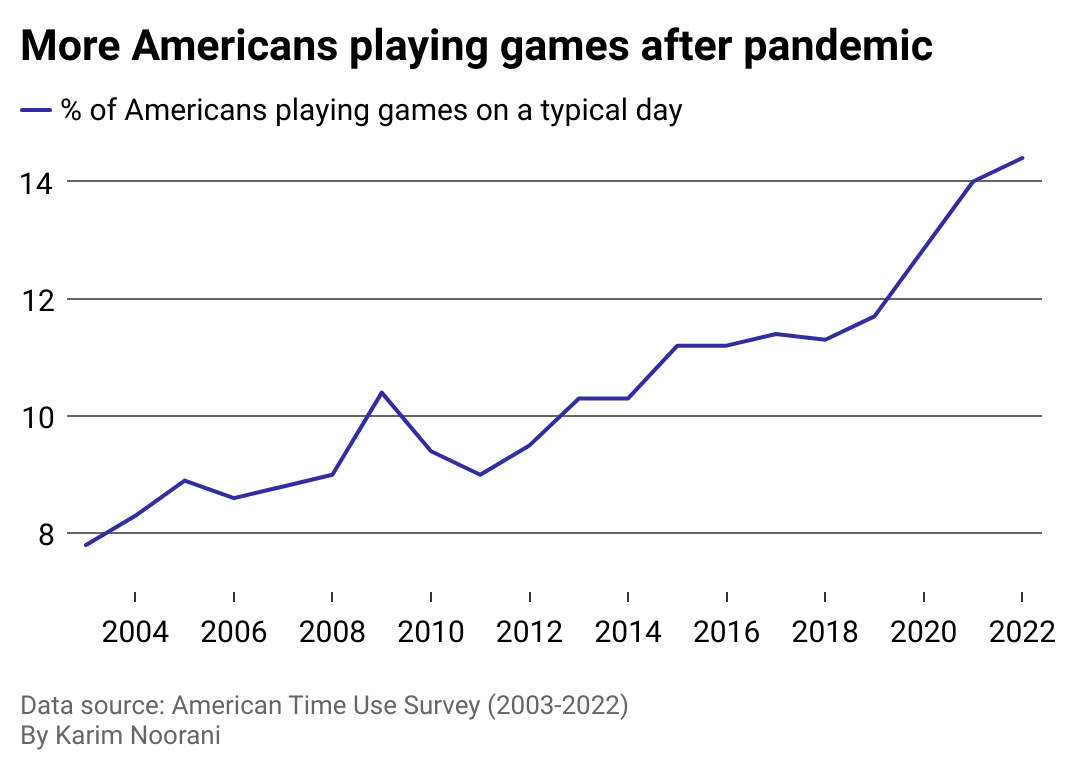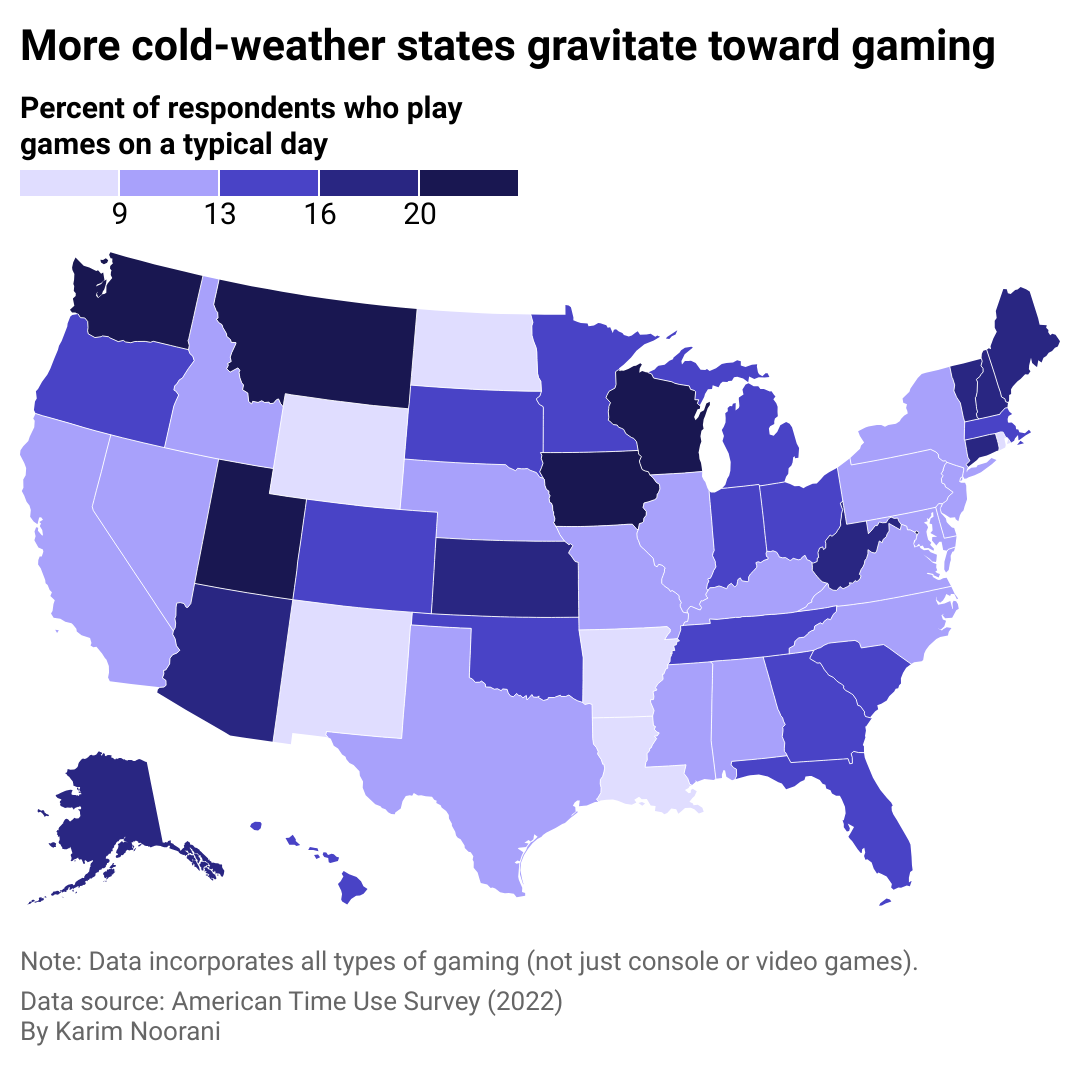In the pandemic, gaming boomed. Which US states have the most players?
Parilov // Shutterstock
In the pandemic, gaming boomed. Which US states have the most players?
Young female gamer playing an online video game.
Gaming in all forms is more prevalent in the world now than ever. From card and board games to tabletop role-playing games to computer and video games, people find various ways to entertain themselves in their free time.
Dungeons & Dragons enthusiasts may try to plan weekly play sessions, online gamers might hop on Discord every night to play Fortnite with friends, and even those who don’t consider themselves gamers will find themselves playing Candy Crush Saga while on the train to work. Needless to say, there are many ways to game today, and more people are participating in growing numbers.
When looking at the United States, in particular, numerous factors contribute to the increasing number of people playing different games. With PC and console video gaming, the industry has grown over the decades to the point where video games make as much or even more money than other mainstream forms of entertainment, like movies. Marketing and publicity for major video games are massive operations, with games competing for people’s time against film and television. With most of the population owning a smartphone, the entry level for gaming is low—and hundreds of thousands of games exist to choose from.
To see how gaming trends differ throughout the U.S., Gamesville looked at data from the American Time Use Survey, which the Census Bureau conducts for the Bureau of Labor Statistics. The 2022 study looks at all 50 states, asking residents if they play games on a typical day. Types of games range from online video games to analog board and tabletop games. Read on to see how big gaming is in your own state.
![]()

Gamesville
Americans gravitating toward gaming
The number of people who play games has steadily increased since the beginning of the 21st century. According to the ATUS, there was a spike in gaming activity in 2009, with more than 10% of U.S. residents regularly playing games—from board games to video games.
At this point in time in the video games industry, Nintendo’s Wii dominates the console market, even appealing to nongamers, thanks to titles like Wii Sports. Meanwhile, the Xbox 360 and PlayStation 3 are pushing bestselling franchises like Halo and Grand Theft Auto, taking the gaming industry to new heights in revenue.
More significant is the advent of smartphone devices, with Apple’s iPhone and Google’s Android operating system launching before 2009, along with their respective app stores. As smartphones became commonplace, the barrier to entry for quick and casual forms of gaming was minimal. Unlike typical console and PC video games, which were $50 to $60 then, most mobile games like Temple Run, Doodle Jump, Angry Birds, and Words with Friends were free to download.
Gaming hit another peak starting in 2020, undoubtedly due to the COVID-19 pandemic and ensuing lockdowns. The ATUS found that at least 1 in 10 people in the U.S. were playing games (13%), with the percentage rising to over 14% by 2022. As movie theaters shut down nationwide and people were isolated in their own homes, newly released social video games like Animal Crossing: New Horizons on Nintendo Switch provided both core and casual gamers with entertainment from home, while others organized virtual board game and tabletop game sessions through programs like Zoom and Discord. Although the production and development of games struggled due to the shift in work-from-home environments, consumers had more time and opportunity to play games during the pinnacle of the pandemic.
According to a 2020 report from market research company The NPD Group, 35% of video gamers found their playtime had increased compared to before the pandemic. Based on a 2022 Entertainment Software Association study, 7 in 10 gamers play on smartphones, and 3 in 5 gamers play on multiple devices, including consoles, phones, and PCs.
According to International Market Analysis Research and Consulting Group research, board games have also grown more popular and are projected to reach $29.7 billion by 2028. Apart from the pandemic, The Washington Post also credits the rise of platforms like Kickstarter, which helps unknown designers release their games, and YouTube channels like Watch It Played with piquing growing interest in these community-building games. The publication declared it a “golden age of board games.”

Gamesville
Montana and Washington lead country in gaming participation
A heat map depicting gaming participation across the country.
The ATUS only provides a snapshot of gaming, but there are a few trends to highlight. For instance, Midwestern states like Wisconsin, Iowa, and Kansas had more respondents who regularly played board and video games. Cold-weather states—like Alaska, Maine, and Vermont—saw higher volumes of gamers, as such weather conditions lead most to seek indoor activities. Washington state is an interesting case, as Seattle is a hub for many large video game development studios.
At the same time, states with major urban areas like New York and California have lower percentages of gamers, according to ATUS data. Minnesota, Utah, and Hawaii have highly ranked internet infrastructures, which may relate to these states’ higher percentages of gamers.
As ESA’s study points out, gaming is a strong way to build community as online platforms allow gamers to connect with other like-minded players in their state or across state lines.
Board and card games accomplish the same thing in person as well. Even before the pandemic, James Zahn, editor-in-chief of trade publication The Toy Book, told The Washington Post about the increased popularity of board game bars, cafes, and conferences. Now, as the world navigates life after the lockdowns, many will surely be looking to gaming both virtual and in person to break the ice and strengthen those community bonds again.
Story editing by Carren Jao. Copy editing by Paris Close. Photo selection by Clarese Moller.
This story originally appeared on Gamesville and was produced and
distributed in partnership with Stacker Studio.






